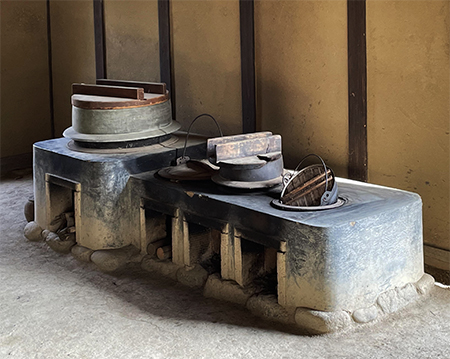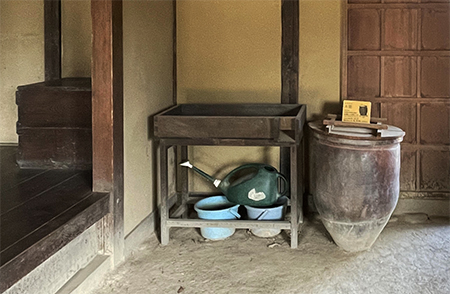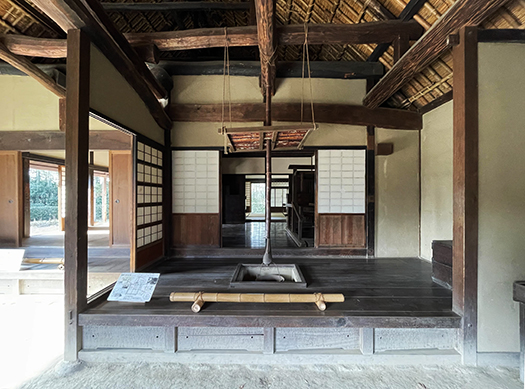


日本的伝統である神仏習合の寺院の庫裡住宅訪問その3であります。
こうした寺院併設の集会機能空間は、日本人の精神性に於いては地域社会の「公民館・会所」的な役割を果たし続けてきたと思われる。公的な性格を濃厚に持った地域の「寄り合い」の空間だったのだと思う。きのう「ひとびとの倫理感の揺りかご」と表現したけれど、この埼玉県さいたま市の一地域にとってみると、神仏習合のこの空間はそのような性格を持っていた。
わたし自身の現場体感では建築外観としてのひとつの典型をみるような思いだった。ヨーロッパ社会ではキリスト教という一神教の精神規範が常識だけれど、日本社会はまったく別の、しかし民族独特の無上な「倫理感」が支配していた。その精神性の実質が、茅葺きの大屋根、せがい造りの外観にシンプルに生きている。帰依するという感覚ではなく、身が引き締まる、こころが無私になる、というような感覚の倫理感。・・・
そういう集会機能のためにはひとびとの食を満たす装置も不可欠。上の写真群は土間にしつらえられたカマド、正面の「流し装置」、そして囲炉裏を囲んでの食堂空間。

無私の精神によって集ったひとびとをやさしく迎え入れる癒やしの装置群。たぶん集会者たちがさまざまな食材を持ち寄って、このカマドや流しを使って調理して、囲炉裏空間で食事したのだろう。やさしく加熱される食材から立ち上る煙、その食材独特の香りが、空間を支配してひとびとのこころを解き放っていったに違いない。この場はそういう共同体意識の結束装置の基盤であるのかも知れない。
「これ、けさ釣り上げた魚があるんだけど・・・」
「おお、それじゃぁ、朝取りの山菜と取り合わせで」
「じゃぁ〆は地鶏なべで(笑)」
食を介した共生感がその寄り合いの度に深まっていった。そういった社会意識が日本人には強く涵養され続けてきたのだと思われる。その機縁が多様な宗教的価値観・八百万の神への信仰であり、みほとけへの尊崇のこころだった。
そういった社会性の再確認の場として日本建築はあり続けたのだろうけれど、日本建築は木造軸組が基本であり、構造材がそのまま表れるのが一般的。正直な木組みが「筋を通して」こうした社会性を無意識下で日本人の精神性を支えていたのだと思う。建築構造もまた素朴な民族的倫理感を構成したに違いない。
ちなみに「筋を通す」という公正性の言語表現はどうも日本独特のようにも思われる。WEBで翻訳コンニャクしてみた。「筋を通す→proceed in a logical manner」語感では日本語と違い「合理的」「ロジカル」というニュアンスが強い。日本語の「誠実さ」といったニュアンスは感じられない。
日本人の精神性と建築の関係もまた、きわめて興味深い。
English version⬇
A space for food that gently welcomes people: The Anrakuji Temple Kori, a branch of the Hikawa Shrine – 3
The Japanese sense of ethics originates from the polytheistic fairness of Shintoism and Buddhist syncretism. We will look at the traces of this in the relationship between the individual and society. …
This is the third part of our visit to a temple kori residence in the Japanese tradition of Shinto/Buddhist syncretism.
These meeting spaces attached to temples are thought to have continued to play the role of “community centers and meeting places” in local communities in the Japanese spirituality. I believe that they were spaces for local “huddling” that had a strong public character. Yesterday I described it as a “cradle of people’s sense of ethics,” and for this area of Saitama City in Saitama Prefecture, this space with its Shinto/Buddhist syncretism had such a character.
In my own experience at the site, I felt as if I was seeing a typical architectural appearance. In European society, Christianity, a monotheistic spiritual code, is the norm, but in Japanese society, a completely different, yet unique, ethnocentric “sense of ethics” prevails. The substance of this spirituality lives simply in the exterior of the thatched roof and the segai-zukuri style. It is not a sense of devotion, but a sense of ethics that makes you tense up and your mind become selfless. The temple is not a place for devotion.
For such a gathering function, it is also essential to have a place where people can eat. The photos above show a kamado (a bamboo stove) on the earthen floor, a “sink” in front of the house, and a dining space with a sunken hearth around the fireplace.
A group of healing devices that gently welcome the gathered people with a spirit of selflessness. Perhaps the participants brought a variety of foodstuffs, cooked them in these kamado and sinks, and ate them in the sunken hearth space. The smoke rising from the gently heated food and the unique aroma of the food must have dominated the space and freed people’s minds. This place may be the foundation of a cohesive device for such a sense of community.
Here, I have some fish I caught this morning…”
“Oh, well, I’ll have some of the morning’s wild vegetables with it.
Then we’ll finish it off with a chicken stew.
The sense of symbiosis through food deepened with each gathering. It is believed that such a social consciousness has been strongly cultivated among Japanese people. The opportunity for this was the belief in a variety of religious values and the belief in the eight million gods, and the reverence for the mihotoke.
Japanese architecture may have continued to exist as a place to reaffirm such sociality, but Japanese architecture is based on wooden framing, and the structural materials are generally expressed as they are. I believe that honest wood framing “through the muscles” supported the Japanese mentality of such sociality in an unconscious way. The architectural structure must have also constituted a simple ethnic ethic.
I tried to translate the Japanese word “musu-suji” into Japanese on the web. The word “suji wo koru→proceed in a logical manner” has a strong nuance of “rational” and “logical,” unlike the Japanese word “sincerity. It does not have the nuance of “sincerity” in Japanese.
The relationship between Japanese spirituality and architecture is also extremely interesting.
Posted on 7月 29th, 2023 by 三木 奎吾
Filed under: 日本社会・文化研究







コメントを投稿
「※誹謗中傷や、悪意のある書き込み、営利目的などのコメントを防ぐために、投稿された全てのコメントは一時的に保留されますのでご了承ください。」
You must be logged in to post a comment.